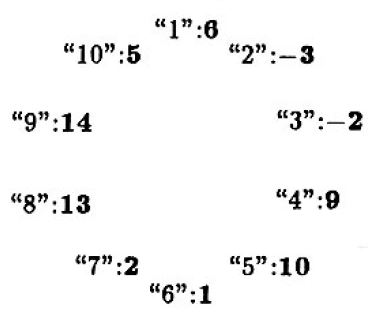Problem:
Ten people form a circle. Each picks a number and tells it to the two neighbors adjacent to him in the circle. Then each person computes and announces the average of the numbers of his two neighbors. The figure shows the average announced by each person (not the original number the person picked). The number picked by the person who announced the average was
Answer Choices:
A.
B.
C.
D.
E. not uniquely determined from the given information
Solution:
Let be the person who announced "" and let be the number picked by . Since the average of the numbers picked by and is picked . Continuing counterclockwise around the table, we find that picked picked picked , and picked . Since , .
Let be the original number picked by the person who announced "". We have a system of ten equations in ten unknowns which has a unique solution:

The sum of the five equations involving the variables with even subscripts yields . Substitute and to obtain . In the figure we show "": where the yield the desired averages, "".
Query. Suppose there had been people instead of . For which is there a unique answer?
Note. This problem is an example of inverting averages. Such problems arise in many applications of mathematics, for instance, the operation of CAT scanners in medicine. To obtain information from a CAT scan, one must invert averages along continuous rays in a disk, rather than averages of discrete points on the perimeter of the disk.